This Speed Twin may have been the last of the “gentleman’s rides,” a motorcycle designed for a customer who really no longer existed. It was intended for the professional fellow who wanted to arrive at work looking spiffy.
To keep the rain and dirt off the trousers it had a broadly valanced front fender and heavily skirted rear wheel enclosure, which was fondly referred to as the “bathtub.” Unfortunately, while this model was being designed and created, the white-collared fellow who was the intended purchaser had gone out and bought himself a car.
While the practical Englishman purchased an Austin Seven, the motorcycling man, especially in the United States, wanted the sporting look. And all that sheet metal did not appeal to him; he wanted a bare-bones bike. This was an epic gaffe, and the man most responsible was no other than the semi-legendary Edward Turner, who was credited with designing the Speed Twin that appeared in 1937.
In truth this short retrospective is as much about the men in the British motorcycle industry as the machines in those years between 1936—the foundation of the Triumph Engineering Company Ltd.—and 1973, when Norton Villiers absorbed Triumph. Names like Edward Turner, Jack Sangster, Bert Hopwood, Jack Wickes—they were as important in the 1950s as Soichiro Honda and Willie G. were in the next generation.
Back in the early 1930s Sangster owned the Ariel motorcycle company. In 1936 he bought the Triumph motorcycle business, putting his Ariel employee, Ed Turner, in charge. He gave Turner a small office and an assistant, designer Bert Hopwood, and an assistant’s assistant, one Jack Wickes, who as a 16-year-old in 1931 had gotten a job at Triumph and learned to wield a nice pencil in the blueprint department. Within a year the three of them came up with the 5T Speed Twin, a 27-horsepower, 500cc vertical twin that looked lean and sporty. It got the public’s attention. Success begets success, and two years later a faster version, the 33-horsepower Tiger 100 appeared—the 100 signified the speed that the Tiger was reputed to reach.
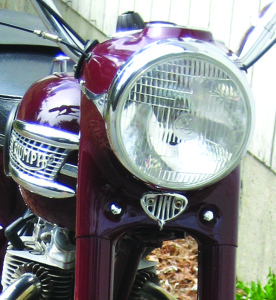
Then the war came along, and Sangster sold the Ariel division to BSA in 1940. In 1942 Turner, a feisty fellow, got in a fight with Sangster, quit, and went to work at BSA. Only to come back the following year. The war ended and Triumph returned to the business of building motorcycles, adding the 350cc 3T to the two 500s. Then Turner got in a fight with Hopwood, who left and went to Norton, where Hopwood developed another vertical twin.
Turner liked to think of his motorcycles as gentlemanly transportation, for gents who wanted power, comfort and elegance. The infamous sprung hub provided a little more comfort, and expanding the engine to 650cc gave more power. Sitting down with Wickes and a blank sheet of paper resulted in a nacelle covering the headlight, providing a place to put the speedometer, ammeter and ignition switch, which resulted in the 1949 Thunderbird 6T.
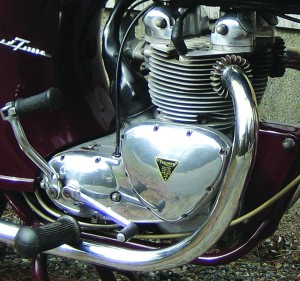
Power was apparently a secondary consideration for Turner. Yes, they had made a GP version of the 500 for a couple of years in 1947 and 1948, but Turner did not really like the racing side of the business. A do-it-yourself race kit, with the Delta dual-carb cylinder head and hot cams, was available for the T100 in 1951. That was the same year that BSA acquired the Triumph company. In 1956 Sangster took over the BSA group, and put Turner in charge of developing and designing Triumph, BSA and Ariel motorcycles. Are you keeping all these names straight?
The U.S. market, which consumed the biggest portion of the Triumph factory’s output, always wanted more power; it provoked the advent of the 650cc, 42-horsepower Tiger 110, soon followed by the sporty-looking TR6, having no nacelle but a separate speedo, tach and chromed headlight. At the same time Turner and Wickes were working on a new 350, the ideal commuter bike. The TwentyOne (for cubic inches) was in the 1957 line, having a very nice unit-construction 350cc engine, with gearbox backed up against the crankcase, simplifying the primary drive. The bore was 58.25mm, stroke, 65.5mm, for 349cc and 18.5 horsepower at 6,500 rpm.
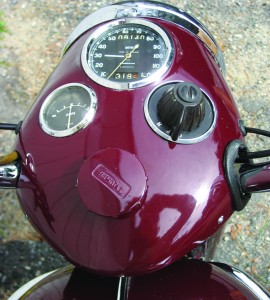
But it certainly lacked any sense of sportiness, as the front fender looked like a skinny helmet, the rear wheel half hidden by the two skirted panels which looked, to the unfocused eye, like a small upside-down bath. Anyone wanting the complete package could opt for the handlebar fairing and leg shields. A very gentlemanly ride, obviously thought Turner, though the derisory English moto-press was fond of referring to gents wearing skirts.
For the 1959 model year the 350 (renamed the 3TA) was bored out to 69mm, creating 490cc, and the 500 5TA Speed Twin appeared, also with the ’tub, claiming 27 horsepower.
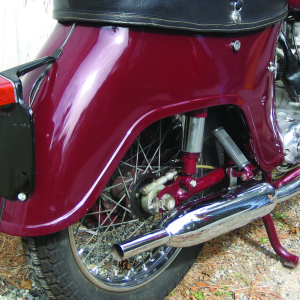
One should not blame just Turner and Wickes for overdressing their bikes; Philip Vincent had signed his motorcycle’s death warrant with the ill-advised 1955 Series D, which had full coverage from handlebars to taillight. Under Turner’s watch the 1958 Ariel Leader was completely enclosed as well. Enclosure was a buzz-word among a few misguided members of the British motorcycle industry; this was the two-wheeled version of the Austin Seven. Somebody forgot to tell them that people who wanted cars bought cars, and people who wanted motorcycles wanted sport.
The American dealers were aghast. When Coventry began putting the bathtub on the Thunderbird and the Tiger 110, it was quickly taken off at U.S. dealers. A breath of fresh air came in 1961 when Hopwood returned to Triumph, only to find that Turner was pushing hard for the enclosed Tina motorscooter—which was a sales flop. Even the sporting T100 suffered some enclosure of the rear wheel, though to a lesser degree than the 5TA. By 1962 Sangster had resigned his BSA chairmanship, and his successor had his own ideas; Turner was well aware
that he was being none-too-gracefully squeezed out, and when he retired in 1964 the skirts went with him.
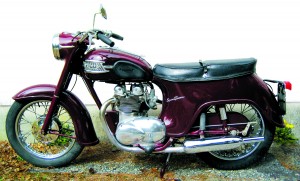








Lovely memories of the 5TA I owned in the 60s. Reg 66GJO Nice bike very reliable still have a pix of it with Craven fairing and pannier set. Thankyou Alan